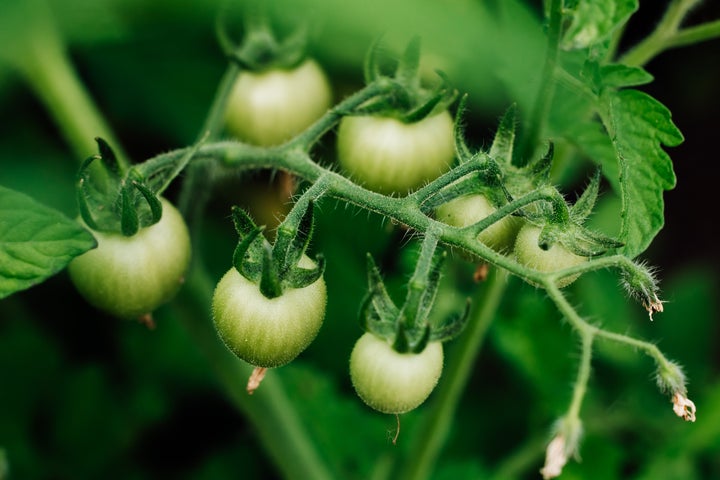
Taking care of tomatoes in the summertime is demanding enough. Even given plentiful sun, great soil, and green-fingered gardener, the plants can be stubborn and resistant to ripening.
Which begs the question; if it’s that hard in the summer, what hope do my still-green tomatoes have in the colder months?
It’s frustrating to watch the fruits you’ve laboured so hard over appear to go to waste. And while there are some tasty recipes you can knock up with green tommies (you can turn them into a tasty chutney, or even crisp them up in an air fryer), the Royal Horticultural Society (RHS) has some advice for those of us who want to reap our ruby rewards.
In their page explaining the most important gardening jobs to do in October, the RHS added a handy tip regarding tomato plants that didn’t reach their summer potential.
So, here’s their sage (teehee) advice, how to do it, and why it works.
Hang your tomato plants upside-down in a greenhouse
You know that hack where you turn an unripe pineapple upside down to encourage it to become sweeter? Yeah, well the same logic goes for your tomato plants.
“Homegrown tomatoes are on borrowed time once the fall rains begin in earnest or nighttime temperatures plummet,” gardening writer Ciscoe Morris shared with The Seattle Times. “Tomatoes that show red coloring can be brought in and will ripen on the counter, but that usually doesn’t work with tomatoes that are still green.”
So, to ripen the truly unready, extra steps should be taken. And yes, that does include trying “the age-old method of hanging the vines upside down to get the green ones to ripen,” Morris says.
The theory goes that the plant’s remaining energy, after being lifted from its soil, will go mostly to the fruits rather than to keeping the rest of the plant alive (the upside-down position makes hanging easier and helps to redirect the energy).
The heat and light in a greenhouse will further help your plants along ― though you can also hang them in your garage or even in your home, as long as they’re protected from the wind and rain.
How do I do it?
First of all, you might want to consider cutting off any flowers before you start hanging the plants. After all, these have “no chance of developing into fruit so nipping them off now will help channel the plant’s energy into ripening existing fruits,” says Gardener’s World.
Then, simply cut the tomato plant at its base (no need to uproot it), gather the stems, tie them, and hang them where you can (ideally a greenhouse, but if you don’t have one, the warmer the better.)
TikToker and gardening enthusiast In My Patch Gardening shared how hers look hanging in her home. “It’s winter here now, and it’s too cold, so hanging them upside down helps ripen them. And anyway, it’s a talking point,” she jokes.
Another green-fingered TikToker, Tiffany PNW, hung hers in her garage. “I cut them at the base so that the plant roots will stay in the soil ― that both feeds the soil and prevents weed seeds from being brought up,” she says.
Once hung, “they’ll probably all be ripened up in about a week,” she shares.
You can watch her video here: